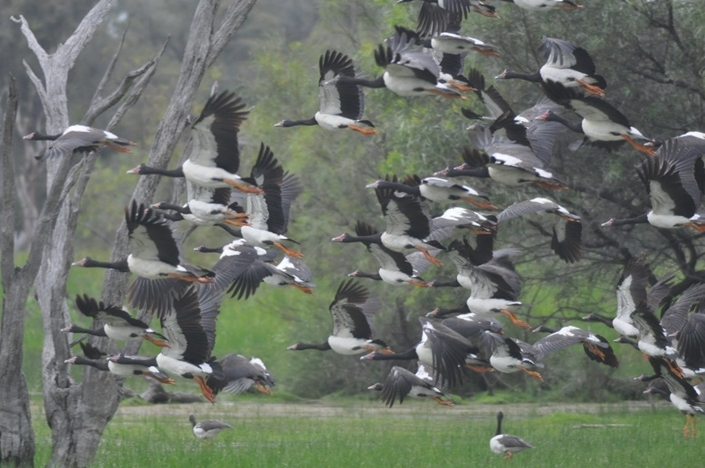Magpie Goose
Scientific name: Anseranas semipalmata
Conservation status in NSW: Vulnerable
Commonwealth status: Not listed
Description
The Magpie Goose is a large, distinctive black and white water-bird (from 70 - 90 cm long) with a prominent knob on the head, and orange legs. It is black at each 'end' - head, neck and upper chest, plus rump and tail - with white body and wings in between. Immature birds have no head-knob and their white parts are mottled grey or brown. It is not a duck or goose, but is regarded as a primitive relative of them.
Source: Pat Johnson/Bullarah
Distribution
The Magpie Goose is still relatively common in the Australian northern tropics, but had disappeared from south-east Australia by 1920 due to drainage and overgrazing of reed swamps used for breeding. Since the 1980s there have been an increasing number of records in central and northern NSW. Vagrants can follow food sources to south-eastern NSW.
Habitat and ecology
• Mainly found in shallow wetlands (less than 1 m deep) with dense growth of rushes or sedges.
• Equally at home in aquatic or terrestrial habitats; often seen walking and grazing on land; feeds on grasses, bulbs and rhizomes.
• Activities are centred on wetlands, mainly those on floodplains of rivers and large shallow wetlands formed by run-off; breeding can occur in both summer and winter dominated rainfall areas and is strongly influenced by water level; breeding occurs in the monsoonal areas of northern Australia and also in our NSW regional wetland areas; nests are formed in trees over deep water; breeding is unlikely in southern Australia.
• Often seen in trios or flocks on shallow wetlands, dry ephemeral swamps, wet grasslands and floodplains; roosts in tall vegetation.

Source: Daryl Albertson/OEH
Threats
• Altered flow regimes to wetland habitats through river regulation, dams, drainage of swamps, ponds and other wetlands for agricultural and other human purposes.
• Destruction of habitat through land clearing and poor water quality ie. pollution
• Modification of habitat and nest loss from trampling, overgrazing and feral pigs.
• Predation on eggs and goslings from feral animals.
• Too-frequent burning of wetlands.
Activities to assist this species
• Undertake feral animal control in known wetland breeding sites.
• Protect breeding habitats from too-frequent fires.
• Protect wetlands from land clearing that removes important habitat.
• Protect wetlands from water pollution by reducing the use of chemicals, monitoring of salinity levels and nutrient loading near wetlands.
• Maintain or restore natural flow regimes in wetlands.
• Protect known or potential wetland habitats from overgrazing.
Recovery strategies
A targeted strategy for managing this species has been developed under the Saving Our Species program. For more information on the Saving Our Species program visit the link below: